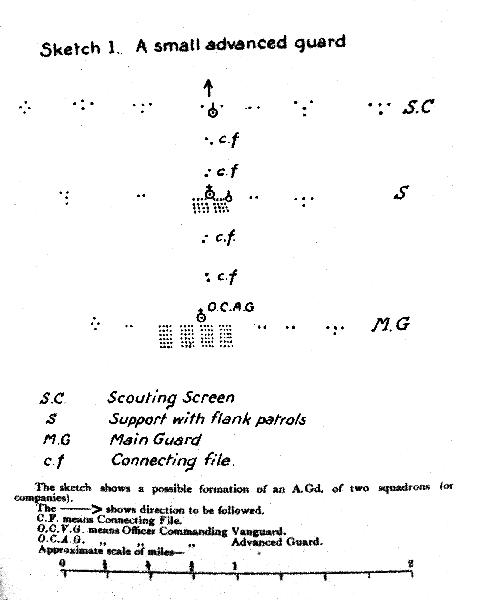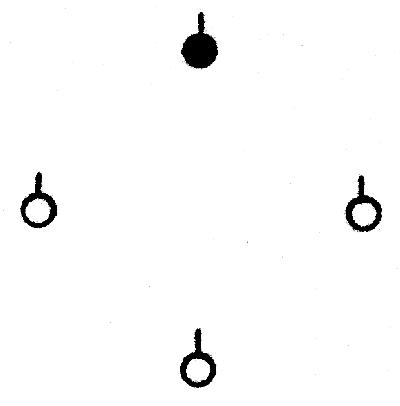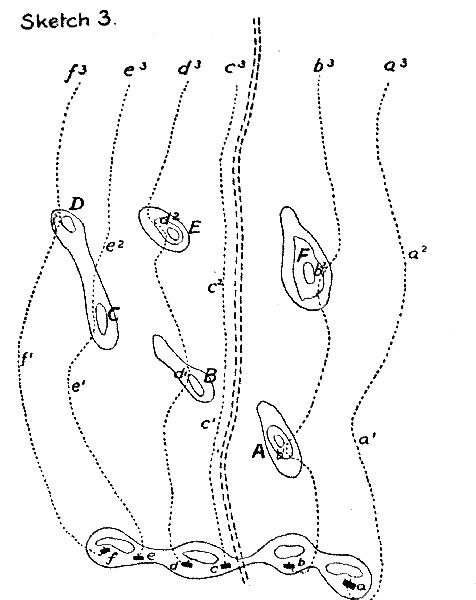Topic: AIF - DMC - Scouts
Scouting or Protective and Tactical Reconnaissance, Part 2
Frederick Allan Dove

3rd Light Horse Brigade Scouts in the hills at Tripoli, December 1918
In 1910, Major Frederick Allan Dove, DSO, wrote a book on a subject he was very familiar with through practical experience called Scouting or Protective and Tactical Reconnaissance. This book set the intellectual framework for the formation of the Brigade Scouts during the Sinai and Palestine Campaigns as part of the Great War.
Dove, FA, Scouting or Protective and Tactical Reconnaissance, 1910.
Method Of Study.
SCOUTING should be studied under two heads:
I. - Protective Scouting.
II. - Scouting for Information by detached Patrols.
In the text-book I. is called Protective, and II. Tactical Reconnaissance.
I will deal first with
I. - Protective Scouting.
Protective Scouting is of a precautionary nature. Upon its proper performance depends the protection of our Columns from annoyance, surprise, and ambush.
Troops within striking distance of the- enemy must throw out Advanced, Flank and Rear Guards. Each of these again pushes out smaller groups, or even individuals, to feel for the enemy. Thus the column is surrounded by a human "Screen," behind which it may march, rest, or manoeuvre, securely hidden from the prying eyes of the foe. The work of this “Screen" will be described in its relation to(A.) The Advanced Guard.
(B.) The Flank Guard.
(C.) The Rear Guard.
(A.) The Advanced Guard Screen Of Scouts.
The distribution of the Advanced Guard into Mainguard and Vanguard is prescribed in F.S. Regs., Section 66, 3, 4. Nothing is said as to the formation of the Vanguard.
It would appear, however, that the essential subdivision should' be into a line of Observation and a line of Resistance; that is to say, into(a) A Screen of Scouts.(b) Supporting Troops.
When the Vanguard consists of both mounted troops and infantry, the former would naturally form the Screen of Scouts and the latter the Supports, which would still provide for their own protection by a few Scouts, who would assist to keep up connection with the cavalry patrols in their front.
1. Formation of the Screen.
It is not at all necessary that the Screen should be a complete unit, such as a troop* or squadron*. [Infantry please read "section" or "company'."] But it is essential that it should be organised into patrols, that each patrol has a leader, and that unity of action is maintained by reference to a directing patrol.
Mounted troops work best in patrols of four men, infantry in either files (two men) or fours. A line of single Scouts is weak in all those points which go to make up good screening work, viz., keeping touch, observation and communication.
There must be a leader in each patrol. By him the other Scouts are controlled, disposed, and moved as his intelligence and training suggests.
There must be a Directing Patrol. With this patrol will march an officer or N.C.O. specially detailed to maintain the correct direction. From the directing patrol all other parts of the Screen maintain touch and direction; it also regulates the average pace of the Screen in conformity with the movements of the Mainguard.
2. - What every man in the Screen must be told.
Before the Vanguard moves off or extends to cover the front, every man in it should be told(a) The Direction of the Advance.This should be done in reference to landmarks if possible; the compass direction given; and attention drawn to the position of the sun, and the direction of the wind, if steady. Landmarks should be pointed out. Important topographical features known to the officer and not immediately visible to the men should be mentioned.
(b) The Frontage to be Searched.In this matter, again, landmarks are the best guide, if available. Scouts to be efficient must have a good eye for the tactical importance of localities. All their movements should be preceded by a brief study of the features of the Country to be traversed. Frontage should never be defined in hundreds of yards, nor should the intervals between patrols or mere be fixed by any other consideration than the nature of, the country.The Scouts must be taught that the Vanguard will always cover as wide a frontage as can be effectively searched by the numbers of men in the Screen.
Put another way, this means that the patrols will keep as far away from one another as they can, without losing touch, and without neglecting the observation of ground where even small bodies of the enemy might lie in ambush.
(c) The Directing Patrol.The Directing Patrol should be named - e.g., "Corporal Smith's patrol will direct." The other leaders will then note their own relative position in the line. This is necessary in order to secure the first essential of Screening work,
Keeping Touch.
This term requires some explanation. The Vanguard is “in touch “with the Mainguard when it can and does maintain ready communication therewith, and is in position to fulfil its duty of reconnaissance. Should the Vanguard get so far in advance that communication is difficult, or should it diverge from its proper direction, and thus uncover the Mainguard, it may be said to have “lost touch." Similarly, a number of patrols are in touch when intercommunication is easy, there is no unsearched ground between them and they do not overlap. In the Scouting Screen touch is kept from the directing patrol. In each patrol the duties can be so allotted as to secure this. For instance, here are three patrols:
Number (3) patrol is directing; in each case he is the leader, b right flanker, c left flanker, and d rear man.
Number (2) patrol keeps touch with number (3) and number (1) patrol keeps touch with number (2). In patrols (2) and (1), the man c has the duty of looking to the touch and letting his leader know how the patrol on his left is moving, or whether it has halted, and to answer and pass on signals or messages. Should number (1) patrol get so far out as to lose touch, it is not the duty of number (2) to follow it but the leader of (2) should at once inform the commander of the Screen. He may then detach one or two of his men to take the" place of number (1) patrol and at the same time to look out for it, and if found bring it back by signal. The Commander of the Screen on his part may send out a fresh patrol if men are at hand, and if not, inform his next senior of what has happened. The fresh patrol would move in between numbers (3) and (2), and the latter would then incline out to take up the duty of the Missing number (1).
(d) To Whom and Where to Report.Rapid passing of information to the O.C. Mainguard is of vital importance. It must be decided on the spot, having due regard to the nature of the country, whether urgent reports can be most quickly transmitted along the line of patrols to the Centre, thence down to the Support, &e., or whether patrols may save time by communicating direct to the Support. In any case the patrol will pass on to neighbouring patrols and to the commander of the Screen any information they obtain.
3. - Extending the Screen.
When the patrols to form the Screen have been told off and the necessary instructions issued, the screen may be extended:-(1) To its full frontage from the halt, and under cover, if available; or
(2) Gradually as it advances, the patrols inclining outwards; or
(3) It may be sufficient at first to have a directing patrol and one or two flanking patrols, the remainder being held back. Later one or more patrols may be sent to either flank, the original flankers being pushed further out.
4. - Movements of the Screen.
The movements of the screen are regulated from and by the directing patrol. But everything favouring of rigidity or drill must be suppressed. The patrol leaders must have considerable latitude and be encouraged to cultivate an eye for country. The duty of all is to co-operate so as to ensure the safe and uninterrupted march of the Mainguard. The directing patrol of course is usually limited in its choice of a line of advance, because its primary function is to maintain the correct direction. The other patrols should under stand that it is their business to protect and assist the directing patrol.. But each leader chooses his own methods of so doing. The movements of a patrol should consist of a series of progressions from one point of observation to another. The intermediate advances should be quick and by the most concealed route. If thought necessary - and it may often he so-one or two men should be left at the last point until the next one is secured.
The average pace of the movement of the Screen is set from the Main Body. This must be constantly borne in mind. But, if the commander of the Screen seas that his patrols have- got into difficult country and that they cannot do their work at the pace required, he will inform his next superior, but make every endeavour to keep going until he receives further orders.
5. - The Directing Patrol.
The Directing Patrol is accompanied by an officer or N.C.O. who is charged with the duty of maintaining the correct direction. Touch is kept between this patrol and the supports by means of Connecting Files (two men). These men are in a position to pass orders up from the Mainguard or reports down from the Screen of Scouts. Their duty is very important, requiring constant vigilance. In each file, one man must particularly watch to the front and the other to the rear.
When the Screen covers a wide front, additional connecting files may be placed in rear of the right Centre and of the left Centre.
6. - Observation.
As before remarked, patrol leaders are particularly charged with the duty of Observation. But they have much to do besides. It is a good plan, therefore, to have one or two special officers or N.C.O.'s told off as "Observers." Theirs is a roving commission. They will proceed to that part of the frontage, being covered which affords the best points for observation. There they remain as long as they think fit, searching the landscape with their eyes, and using the field-glasses to examine doubtful localities or objects. When satisfied they move on to the next good outlook. They must be men of keen sight and with a sound appreciation of the tactical importance of the ground presented to their view. They will be of greatest value if they are cool and alert when the Scouts eventually draw fire vide Contact with the Enemy.
Previous: Part 1, Preface & Introduction
Next: Part 3, Communication
Further Reading:
Obituary, Frederick Allan Dove
Australian Light Horse Militia
Battles where Australians fought, 1899-1920
Citation: Brigade Scouts, Scouting or Protective and Tactical Reconnaissance Part 2 Protective Scouting














